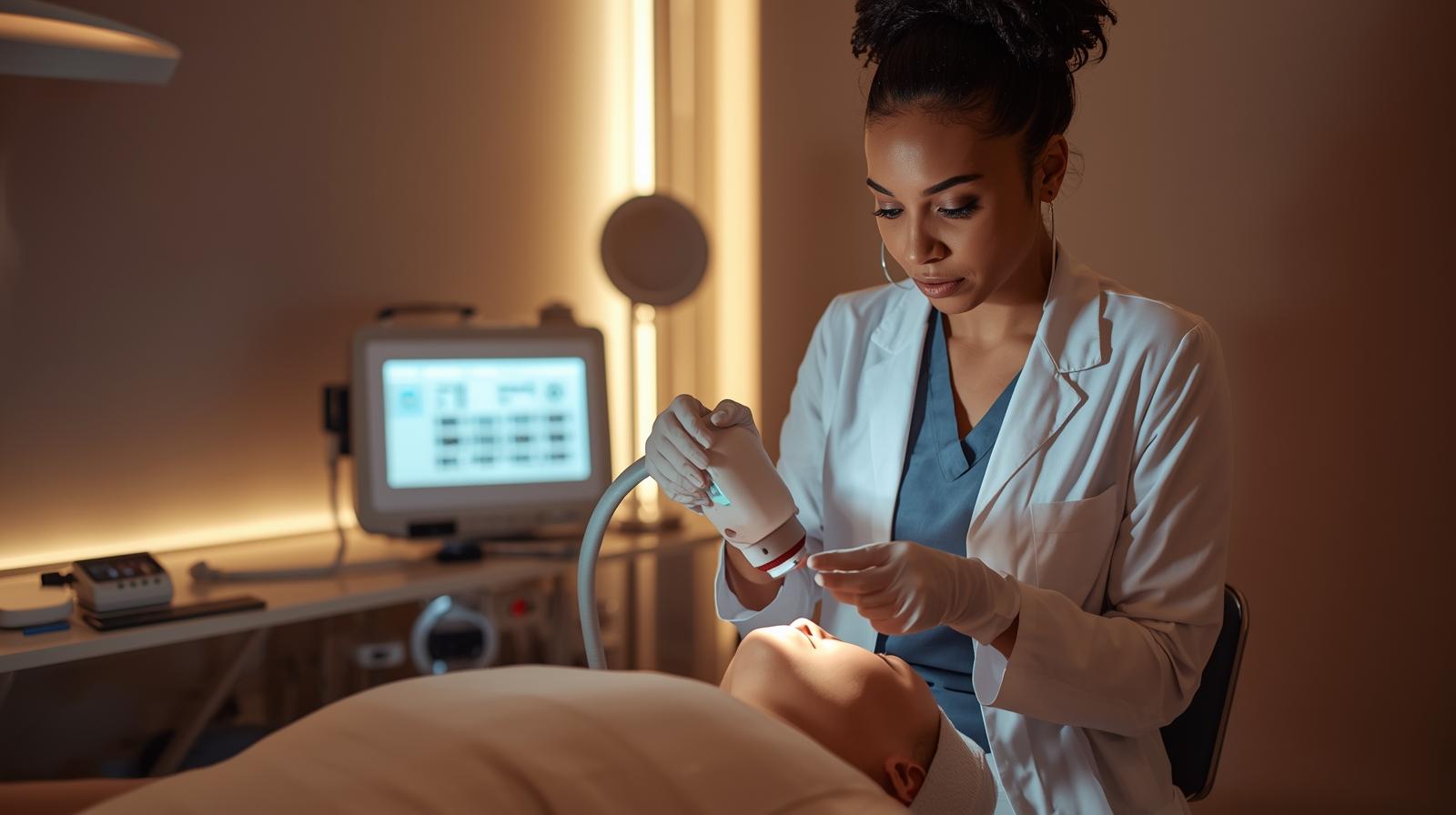How to Get into Aesthetics. Read it here.
Building a Career as a Cosmetic Nurse Practitioner: What Every NP Should Know. Read it here.
From Bedside to Brand: A Nurse Practitioner's Path to Cosmetic Chemistry. Read it here.
The Engineer Behind the Formula: How to Redefine Aesthetics. Read it here.
When we talk about the future of aesthetic medicine, the devices that safely sculpt, resurface, and regenerate, we are fundamentally talking about the work of the Biomedical Engineer (BME). This role sits at the critical intersection of advanced engineering principles and biological/medical needs. The BME is the architect who designs, develops, tests, and validates every piece of high-tech equipment we use in our clinics: from the sophisticated laser systems that treat hyperpigmentation on diverse skin tones to the radiofrequency micro-needling devices that build collagen.
As Nurse Practitioners, we are the experts in human factors, how a machine interacts with the patient and the outcome it delivers. The Biomedical Engineer is the expert in the machine's architecture, the wavelength, the energy delivery, the safety mechanisms, and the rigorous testing required for FDA approval. Their work ensures that the tools we use are not just innovative, but legally sound, safe, and effective. For the NP founder, understanding the BME's world is crucial because it’s the only way to strategically invest in technology that drives superior patient outcomes and minimizes risk in your practice.
The evolution of the aesthetic industry from simple, mechanical procedures to high-tech, precise modalities is a story written by BMEs. It began in earnest with the development of the first medical lasers and imaging technologies in the mid-20th century. Before engineers were involved, treatments were often imprecise, leading to inconsistent results and higher complication rates, especially for patients with skin of color who are at a higher risk for post-inflammatory hyperpigmentation (PIH).
The shift was monumental. Engineers began applying physics and materials science to biology. Think about the progression from the simple continuous wave lasers of the 1960s to the development of Q-switched and picosecond lasers today. That leap was driven by BMEs figuring out how to deliver energy in billionths of a second, shattering pigment safely with minimal thermal damage to surrounding tissue. This specialization was a necessary response to the demand for precision, allowing clinicians to treat complex conditions like melasma and tattoo removal effectively across the entire Fitzpatrick scale. The Biomedical Engineer didn't just innovate a tool; they engineered safety and efficacy into the very foundation of modern aesthetic practice.
The medical device market is a behemoth, driven by a global patient demand for non-invasive aesthetic solutions. Leading companies like Cynosure, Candela, and Alma Lasers are all fundamentally engineering firms staffed by BMEs. The market is projected for massive growth, largely because new technologies, like next-generation energy-based devices and AI-integrated diagnostic tools, are constantly emerging.
The primary growth drivers are non-invasive body contouring, skin tightening, and pigmentation correction. This presents a massive opportunity for the ethical founder.
Founder's Focus: Why This Matters to You
This growth means continuous hardware innovation. Your Return on Investment (ROI) hinges on understanding the engineering science, you must be able to evaluate if a new device's improved wavelength or energy delivery system (the BME's work) translates into superior, safer results for your patient base, especially if you specialize in treating skin of color. Without this knowledge, you risk making a six-figure investment in obsolete technology.
The AI Integration
Artificial Intelligence is already being integrated into BME work. Current applications include using AI for predictive maintenance on sophisticated laser systems, optimizing treatment parameters based on patient outcomes, and diagnostic imaging to identify subsurface skin structures. The future will see BMEs designing devices that use AI to personalize energy delivery in real-time, drastically reducing the risk of human error.
The Bottlenecks
The primary bottlenecks are regulatory uncertainty (navigating FDA approval for novel devices) and the disconnect between the clinic and the lab. Engineers often design for theoretical perfection, while NPs understand the reality of patient compliance, discomfort, and operational efficiency. This gap creates opportunities for NPs to consult with BME firms.

Your next step is to elevate your technological literacy. Stop accepting sales pitches at face value.
The policy landscape in aesthetic technology is a direct reflection of the need for stronger BME-clinical collaboration. As Nurse Practitioners, our voice is essential in shaping standards that protect patients and legitimize our practices.
The career path for an NP who masters BME literacy extends far beyond the traditional clinic structure.
The traditional NP curriculum does not teach you BME principles, so you must seek this knowledge intentionally. Your background in pathophysiology and pharmacology is a strong base, but you need to overlay the language of engineering.
Finding a mentor in the BME space is challenging, but rewarding. Your mentor shouldn't be another NP; it should be a Biomedical Engineer who designs devices.
To assess if this path aligns with your visionary spirit, consider the strategic challenges and opportunities:

Before you pivot into this high-stakes world, you must understand a few realities. This work requires meticulous attention to regulatory compliance, there is no room for the kind of 'gray area' flexibility you might find in some aesthetic clinics. Your work will shift from hands-on patient interaction to data and documentation. You must be comfortable translating complex human experiences (like patient pain scores) into quantifiable data that an engineer can use. Your credibility is your most important asset, and it is built on flawless, evidence-based reporting.
Your ambition to not only use the tools of modern aesthetics but to design and validate them is the definition of true leadership. You are uniquely positioned to leverage your clinical rigor to ensure that the next generation of aesthetic devices is inherently safer, more effective, and profoundly more equitable for all patients. Embrace the science, own your expertise, and build a legacy that changes the technology used in every clinic worldwide.
This path requires a high tolerance for ambiguity, long development cycles, and detailed, technical work. This is not a quick profit path. You must ask yourself: Do I have the patience to work on a single product for 3 to 5 years, navigating clinical trials and FDA submissions? Am I willing to trade hands-on patient flow for systems design and regulatory deep dives? If the answer is no, that’s okay. The market needs you as an expert provider. But if the answer is yes, you are ready to pivot from being a user of technology to being a creator of the future of aesthetic medicine.
When educating your patients about the technology behind their aesthetic treatments, clarity builds trust and confidence. Here are seven teaching points that translate complex engineering into patient-friendly language:
"Your device was engineered specifically for your skin." Modern aesthetic devices aren't one-size-fits-all. Explain that biomedical engineers design laser wavelengths and energy settings based on how different skin tones absorb light. This is why your practitioner adjusts settings based on your skin phototype, it's not just preference, it's physics working to keep you safe.
"The 'zap' you feel is measured in billionths of a second." Help patients understand that today's picosecond and nanosecond lasers deliver energy so quickly that surrounding tissue doesn't have time to overheat. This precision, engineered over decades, is why modern treatments have fewer complications than older technologies. The speed isn't just for efficiency, it's your safety mechanism.
"FDA approval means years of engineering testing, not just provider opinions." Patients often don't realize that before a device reaches your clinic, biomedical engineers spent years testing its safety profile, efficacy data, and failure modes. When you choose an FDA-cleared device, you're benefiting from rigorous engineering validation, not just marketing claims.
"Your treatment plan is based on engineering data, not guesswork." Explain that the number of sessions, the energy levels, and the intervals between treatments are all determined by clinical trial data that engineers and dermatology nurse practitioners developed together. This helps patients understand why you can't simply "turn it up higher" or "do it faster"—the protocols are engineered for optimal, safe outcomes.
"The cooling system is just as important as the laser itself." Many patients focus only on the laser or radiofrequency component, but engineers design sophisticated cooling mechanisms that protect your epidermis while treating deeper layers. That cooling sensation isn't a luxury feature, it's a critical safety system that prevents burns and allows for more aggressive treatment of the target tissue.
"Newer isn't always better, engineering refinement takes time." In an industry that constantly markets "the latest technology," educate patients that the most reliable devices are often refined versions of established platforms. Biomedical engineers spend years perfecting energy delivery systems. A newly released device hasn't had time to show long-term safety data across diverse populations, which is why experienced practitioners often prefer proven, refined technology.
"Your results depend on both the machine and the person using it." While the device is engineered for precision, the practitioner's understanding of how to apply that technology to your unique anatomy makes the difference. Engineers create the tool, but your Nurse Practitioner's clinical expertise ensures it's used correctly for your specific concerns, skin type, and cosmetic goals.
The future of aesthetic medicine belongs to the Nurse Practitioners who refuse to be passive users of technology and instead become architects of innovation. You are not simply learning to operate devices, you are mastering the language of the biomedical engineers who create them, positioning yourself to influence every stage of technology development from concept to clinical application. This is your invitation to step beyond the limitations of traditional NP practice and into a role where your clinical expertise shapes policy, drives safety standards, and creates wealth through consulting, education, and entrepreneurship. The devices that will define the next decade of aesthetic medicine are being designed right now, and the clinicians who understand their engineering foundation will lead the field. Your patients, your profession, and the industry need your voice. This is not just a career path, it is a mandate for leadership, equity, and excellence. The question is not whether you are qualified for this work, but whether you are ready to claim it.
Want to dive deeper into this research? Alliance of Cosmetic Nurse Practitioners™ members get exclusive access to an audio discussion of this article, including expanded commentary on the DNP project ideas, PhD research opportunities, and entrepreneurial strategies. Join the Alliance to access the full audio library and connect with NP founders translating research into practice and revenue.
About the Author
Dr. Kimberly Madison, DNP, AGPCNP-BC, WCC, is a Board-Certified, Doctorally-prepared Nurse Practitioner, educator, and author dedicated to advancing dermatology nursing education and research with an emphasis on skin of color. As the founder of Mahogany Dermatology Nursing | Education | Research™ and the Alliance of Cosmetic Nurse Practitioners™, she expands access to dermatology research, business acumen, and innovation while also leading professional groups and mentoring clinicians. Through her engaging and informative social media content and peer-reviewed research, Dr. Madison empowers nurses and healthcare professionals to excel in dermatology and improve patient care.